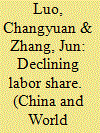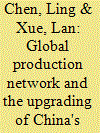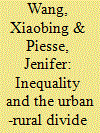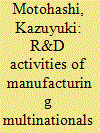|
|
|
Sort Order |
|
|
|
Items / Page
|
|
|
|
|
|
|
| Srl | Item |
| 1 |
ID:
099912


|
|
|
|
|
| Publication |
2010.
|
| Summary/Abstract |
In this paper, we investigate whether the mutual satisfaction of Chinese banks and foreign strategic investors (FSI) in terms of their cooperation with each other affects the performance of Chinese banks. Since 2004, China's banking authority has conducted an annual survey on Chinese banks and their FSI, assessing levels of mutual satisfaction in terms of their cooperation. We use these survey results to examine the effects of satisfaction levels on the profitability of Chinese banks. Our results reveal that satisfaction affects profitability; that is, satisfied foreign investors and Chinese banks yield better performance. Satisfaction determinants for each party are also examined. Although the profitability of Chinese banks does not show a significant effect on the satisfaction of either party, bank loan to deposit ratios, regions of FSI home countries, and the type of Chinese banks are important factors that might affect satisfaction.
|
|
|
|
|
|
|
|
|
|
|
|
|
|
|
|
| 2 |
ID:
099907


|
|
|
|
|
| Publication |
2010.
|
| Summary/Abstract |
This paper explores why labor share in China has declined since the middle of the 1990s. Existing literature usually ascribes the labor share decline in developed countries to biased technological progress. However, our investigation shows that China's case is different. Using a simultaneous equation model estimated with three-stage least squares, we find that FDI, levels of economic development and privatization have negative effects on the labor share. The negative influence of FDI on labor share results from regional competition for FDI, which weakens labor forces' bargaining power. A U-shaped relationship exists between labor share and the level of economic development, and China is now on the declining part of the curve. The negative effects of privatization on the labor share stem from the elimination of the so-called "wage costs eroding profit" situation and the positive supply shock on the labor market.
|
|
|
|
|
|
|
|
|
|
|
|
|
|
|
|
| 3 |
ID:
099913


|
|
|
|
|
| Publication |
2010.
|
| Summary/Abstract |
Using an analytical framework of the global production network (GPN), the present paper examines the external environment and the internal dynamics of China s integrated circuit (IC) industry. We analyze the transition of China s IC industry from a state-led integrated device manufacturers' model to deeper integration into the GPN. We also explore the technological sources, the upgrading dynamics as well as the positioning of different nodes of China s IC industry in the GPN. We conclude that the "East Asia model" of gradual industrial upgrading might not apply anymore in the new era of GPN. High-technology industries can now be upgraded based on a parallel evolution model. Policy implications for China's high-technology industrial upgrading strategies are drawn from our analysis.
|
|
|
|
|
|
|
|
|
|
|
|
|
|
|
|
| 4 |
ID:
099911


|
|
|
|
|
| Publication |
2010.
|
| Summary/Abstract |
This paper investigates the link between hot money and business cycle volatility in China from January 1997 to December 2009. Using the structural vector error correction model, we find a considerable degree of long-run cointegration and bidirectional causality effects between hot money and business cycle volatility. The speculative shocks are found to temporarily promote China's economic growth, but also to exacerbate business cycle volatility. The liquidity shock stemming from hot money is shown to be the primary factor responsible for the significantly enhanced fluctuation in business cycles during the most recent global financial crisis period. This could be detrimental to the smooth operation of financial markets. Therefore, in forming future policies, it is critical for policy-makers to take precautions against the speculative factors.
|
|
|
|
|
|
|
|
|
|
|
|
|
|
|
|
| 5 |
ID:
099909


|
|
|
|
|
| Publication |
2010.
|
| Summary/Abstract |
Using three comparable national representative household surveys for China in 1988, 1995 and 2002, the present paper reveals the regressivity and urban bias of China's direct tax and welfare system in this period. It shows that a regressive taxation system and skewed allocation of subsidies increases the urban-rural income gap and enhances overall inequality. Modeling these relationships indicates that the relatively poorer rural population has a net tax liability, whereas those in the richer urban areas receive net subsidies. This pattern is common in China, although the extent of the bias varies. This skewed system of tax and welfare payments is a major cause of the persisting urban-rural income gap and contributes to the overall income inequality in China. The abolishment of the agriculture tax in 2006 has had a positive impact on rural people's livelihoods.
|
|
|
|
|
|
|
|
|
|
|
|
|
|
|
|
| 6 |
ID:
099910


|
|
|
|
|
| Publication |
2010.
|
| Summary/Abstract |
This paper investigates the R&D motivations of various multinationals operating in China, drawing on a large-scale, firm-level dataset of official Chinese statistics on science and technology activities. The present study shows that R&D efforts in China have intensified for both foreign-owned and domestic firms, but less so for foreign-owned firms, perhaps because foreign-owned firms tend to operate on a foundation of technological capabilities developed within their home countries.
Statistical analysis confirms that the major motivations for foreign R&D in China are production-driven, not market-driven or technology-driven. Nevertheless, one sees significant variations in foreign R&D strategies from region to region. Guangdong is characterized by production-driven R&D. In Beijing, R&D strategies tend to take a technology-driven approach, drawing on the clusters of scientific institutions. In Shanghai, the R&D efforts of multinationals tend to focus on support for market-driven R&D.
|
|
|
|
|
|
|
|
|
|
|
|
|
|
|
|
| 7 |
ID:
099908


|
|
|
|
|
| Publication |
2010.
|
| Summary/Abstract |
In the present paper, we estimate the de facto RMB exchange rate regime, the currency basket, the floating band and the foreign exchange market pressure before and after the reform of the Chinese exchange rate regime in 2005. We find the following stylized facts: the value of the RMB became stable after the reform; the weight of the US dollar remained high in the basket, while other currencies remained statistically significant; and the floating band gradually increased to 10 percent during 2005-2008, and then greatly narrowed from the late summer of 2008 under the assumption of a yearly resetting interval. We find that the foreign exchange market pressure increased from 2005 to 2008. A possible reason is that the weight of the US dollar in the basket was slightly lower than the share of the US dollar in total transactions on the Chinese foreign exchange market. Therefore, it is reasonable for China to adopt a dollar peg exchange rate regime.
|
|
|
|
|
|
|
|
|
|
|
|
|
|
|
|
|
|
|
|
|